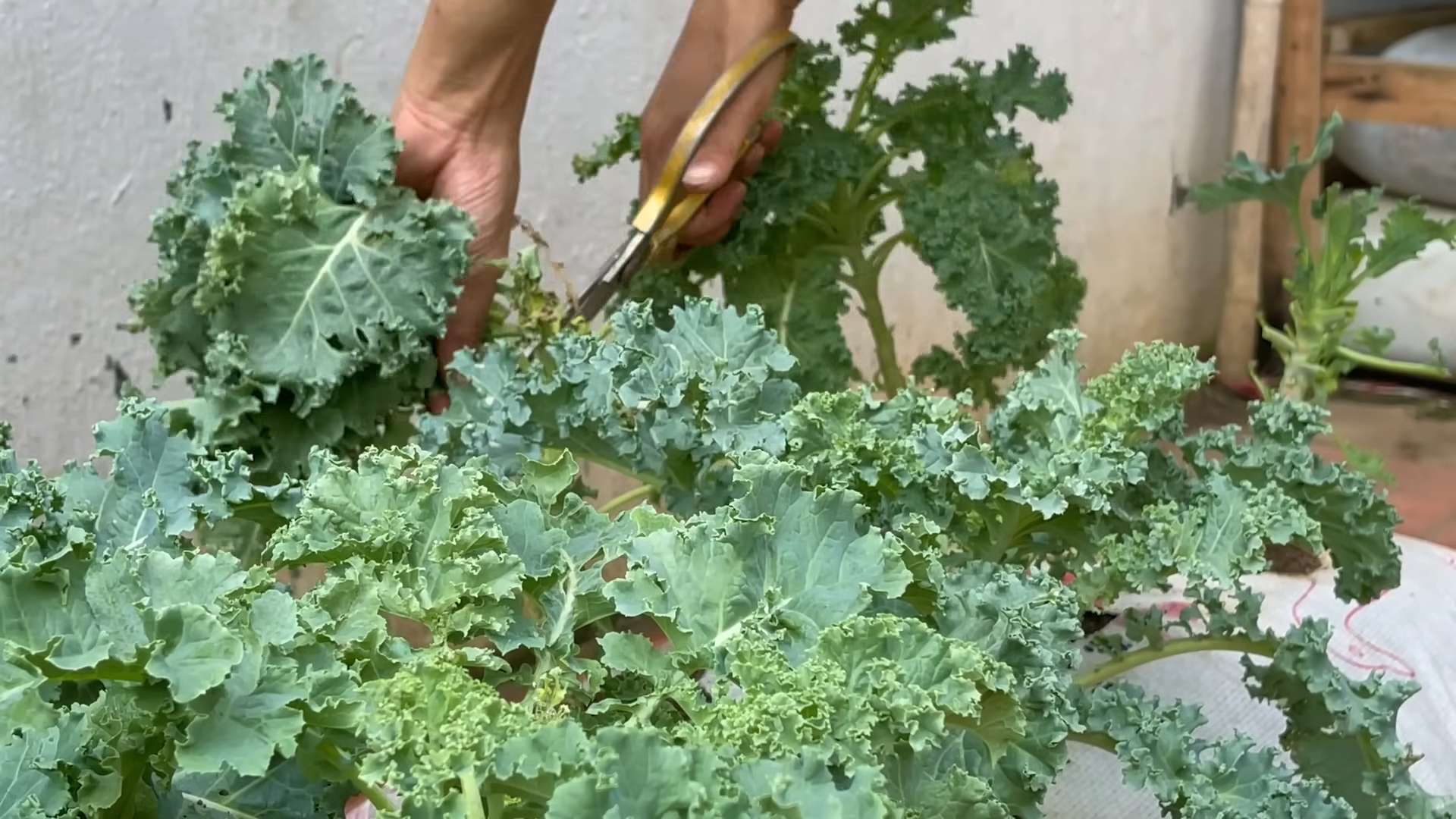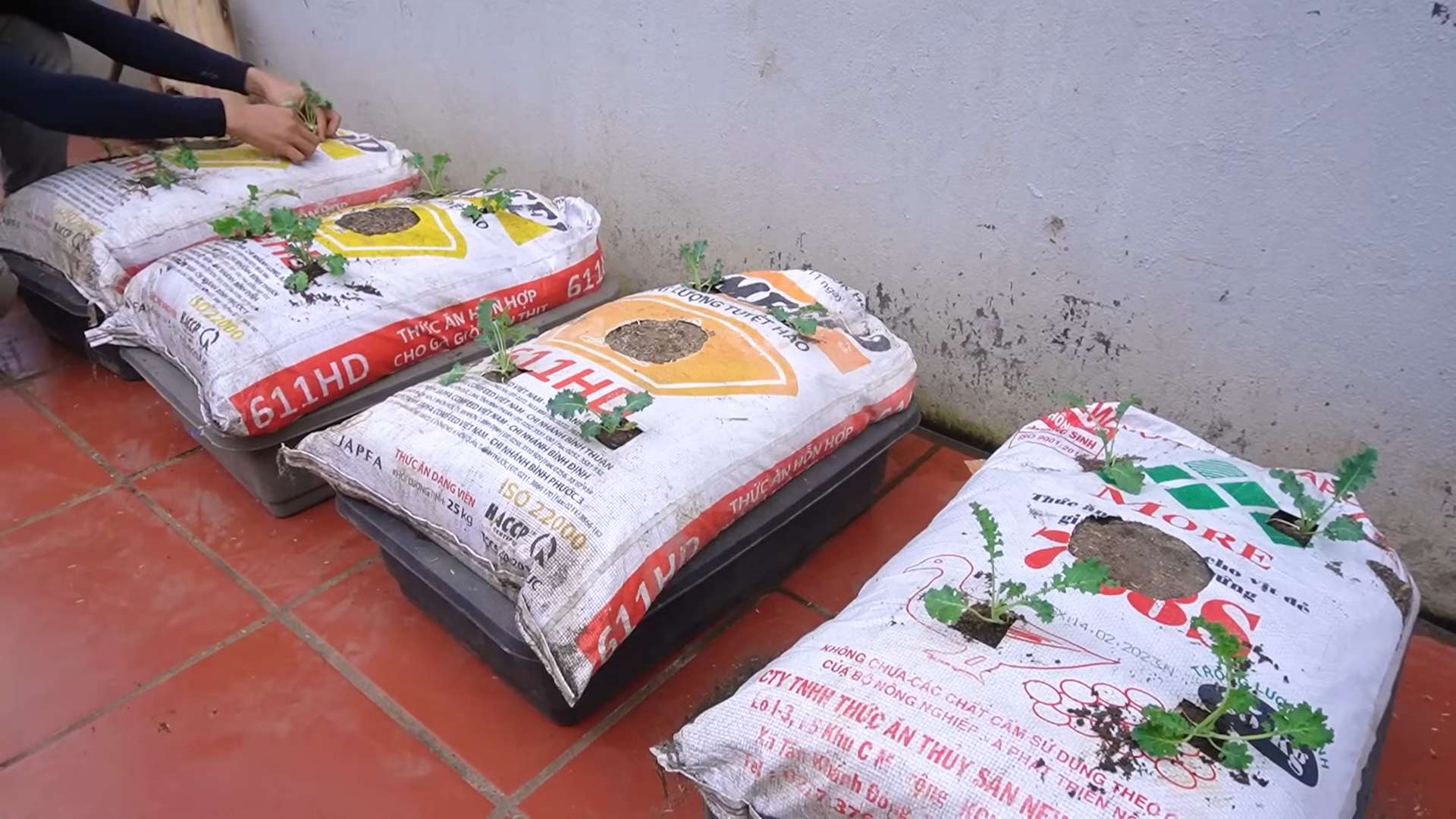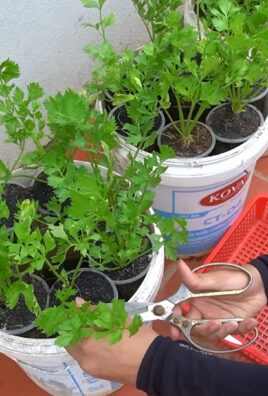Kale Growing for Beginners can seem daunting, I know! You might picture endless rows of perfectly formed, vibrant green leaves and think, “That’s just not me.” But trust me, growing your own kale is surprisingly easy and incredibly rewarding. Forget those expensive, pre-packaged greens at the grocery store – imagine stepping into your backyard and harvesting fresh, nutritious kale whenever you want!
Kale has a rich history, dating back to ancient Greece and Rome, where it was a staple food. Over centuries, it’s been celebrated for its hardiness and nutritional power. Today, with a growing emphasis on healthy eating and sustainable living, kale has experienced a major resurgence. But why buy it when you can grow it yourself?
In this DIY guide, I’m going to share some simple, yet effective tricks and hacks that will transform you from a gardening newbie into a kale-growing pro. We’ll cover everything from choosing the right seeds and preparing your soil to protecting your precious plants from pests and diseases. Kale Growing for Beginners doesn’t have to be intimidating. With a little guidance and these easy-to-follow tips, you’ll be enjoying delicious, homegrown kale in no time. Let’s get started!

Growing Kale Like a Pro: A Beginner’s Guide
Hey there, fellow garden enthusiasts! So, you’re thinking about growing kale? Awesome choice! Kale is a nutritional powerhouse, super easy to grow, and surprisingly versatile in the kitchen. I’m going to walk you through everything you need to know to get started, from choosing the right variety to harvesting your first batch of delicious, leafy greens. Trust me, even if you’ve never grown anything before, you can totally do this!
Choosing Your Kale Variety
Before we get our hands dirty, let’s talk kale varieties. There are tons of different types, each with its own unique flavor and texture. Here are a few of my favorites:
* **Curly Kale (Scotch Kale):** This is probably the kale you’re most familiar with. It has tightly curled, frilly leaves and a slightly bitter taste. It’s great for kale chips!
* **Lacinato Kale (Dinosaur Kale or Tuscan Kale):** Also known as cavolo nero, this kale has long, dark green, almost black leaves with a slightly bumpy texture. It has a milder, sweeter flavor than curly kale and holds up well in soups and stews.
* **Red Russian Kale:** This variety has flat, fringed leaves with purple stems. It’s sweeter and more tender than curly kale, making it perfect for salads.
* **Redbor Kale:** This kale is grown more for its ornamental value than its taste, but it is still edible. It has deeply ruffled, purple leaves that add a pop of color to any garden.
Consider your taste preferences and what you plan to use the kale for when making your choice. I personally love having a mix of Lacinato and Red Russian in my garden!
Getting Started: Planting Kale
Okay, let’s get down to the nitty-gritty! You can start kale from seeds or buy seedlings from your local garden center. I usually start from seeds because it’s more economical, and I enjoy watching them sprout.
Starting from Seeds:
1. **Timing is Key:** Kale is a cool-season crop, so the best time to plant it is in early spring or late summer. For a spring crop, start your seeds indoors about 6-8 weeks before the last expected frost. For a fall crop, sow seeds directly into the garden in late summer.
2. **Indoor Seed Starting (Optional):** If you’re starting indoors, you’ll need seed starting trays or small pots, seed starting mix, and a spray bottle.
* Fill your trays or pots with seed starting mix.
* Moisten the mix with the spray bottle. You want it damp, not soggy.
* Sow 2-3 seeds per cell or pot, about ¼ inch deep.
* Gently cover the seeds with more seed starting mix.
* Water again with the spray bottle.
* Place the trays or pots in a warm, sunny location or under grow lights.
* Keep the soil consistently moist until the seeds germinate, which usually takes 5-10 days.
3. **Direct Sowing:** If you’re sowing directly into the garden, choose a sunny spot with well-drained soil.
* Prepare the soil by removing any weeds and rocks.
* Amend the soil with compost or other organic matter to improve drainage and fertility.
* Sow the seeds about ½ inch deep and 1-2 inches apart.
* Gently water the soil.
* Keep the soil consistently moist until the seeds germinate.
4. **Thinning Seedlings:** Once your seedlings have a few true leaves (the leaves that look like miniature kale leaves), you’ll need to thin them out. This means removing some of the seedlings so that the remaining ones have enough space to grow.
* If you started seeds indoors, transplant the strongest seedling from each cell or pot into a larger pot.
* If you direct sowed, thin the seedlings to about 12-18 inches apart.
Transplanting Seedlings:
1. **Harden Off Your Seedlings:** Before transplanting your seedlings into the garden, you’ll need to “harden them off.” This means gradually exposing them to outdoor conditions so they don’t get shocked by the sudden change in temperature and sunlight.
* Start by placing the seedlings outdoors in a sheltered location for a few hours each day, gradually increasing the amount of time they spend outside over the course of a week.
* Protect them from direct sunlight and strong winds.
2. **Prepare the Planting Bed:** Choose a sunny spot in your garden with well-drained soil.
* Amend the soil with compost or other organic matter.
* Make sure the soil is loose and easy to work with.
3. **Transplant the Seedlings:** Dig holes that are slightly larger than the root balls of your seedlings.
* Gently remove the seedlings from their pots and place them in the holes.
* Backfill the holes with soil and gently firm the soil around the base of the plants.
* Water the seedlings thoroughly.
4. **Spacing:** Space your kale plants 12-18 inches apart. This will give them enough room to grow and prevent overcrowding.
Caring for Your Kale Plants
Once your kale plants are in the ground, it’s important to provide them with the care they need to thrive.
1. **Watering:** Kale needs consistent moisture, especially during hot, dry weather. Water deeply whenever the top inch of soil feels dry. Avoid overwatering, as this can lead to root rot.
2. **Fertilizing:** Kale is a heavy feeder, so it benefits from regular fertilization.
* Apply a balanced fertilizer (like 10-10-10) every 4-6 weeks.
* You can also side-dress your plants with compost or other organic matter.
3. **Weeding:** Keep your kale patch free of weeds, as they can compete with your plants for nutrients and water.
* Hand-pull weeds regularly or use a hoe to cultivate the soil around your plants.
* Mulching can also help to suppress weeds.
4. **Pest Control:** Kale is relatively pest-resistant, but it can be susceptible to aphids, cabbage worms, and flea beetles.
* Inspect your plants regularly for signs of pests.
* If you find pests, you can try hand-picking them off the plants or spraying them with insecticidal soap or neem oil.
* Floating row covers can also help to protect your plants from pests.
5. **Sunlight:** Kale needs at least 6 hours of sunlight per day to thrive. Make sure you plant it in a location that gets plenty of sun.
Harvesting Your Kale
Now for the best part – harvesting! You can start harvesting kale leaves as soon as they are large enough to eat, usually about 6-8 inches long.
1. **Harvesting Technique:** The best way to harvest kale is to pick the outer leaves, leaving the inner leaves to continue growing.
* Start from the bottom of the plant and work your way up.
* Use a sharp knife or scissors to cut the leaves off close to the stem.
* Avoid damaging the central bud of the plant, as this will prevent it from producing new leaves.
2. **Continuous Harvest:** Kale is a cut-and-come-again crop, meaning you can harvest leaves from the same plant multiple times.
* As long as you don’t harvest all of the leaves at once, your kale plants will continue to produce new leaves throughout the growing season.
3. **Storage:** Freshly harvested kale will keep in the refrigerator for up to a week.
* To store kale, wash it thoroughly and dry it with a salad spinner or paper towels.
* Wrap the kale in a damp paper towel and store it in a plastic bag in the refrigerator.
Troubleshooting Common Kale Problems
Even with the best care, you might encounter a few problems when growing kale. Here are some common issues and how to address them:
* **Yellowing Leaves:** This can be caused by a variety of factors, including nutrient deficiencies, overwatering, or pests.
* Make sure your kale plants are getting enough fertilizer and water.
* Check for pests and treat them accordingly.
* If the problem persists, consider getting a soil test to determine if there are any nutrient deficiencies.
* **Holes in Leaves:** This is usually caused by cabbage worms or flea beetles.
* Inspect your plants regularly for signs of pests.
* Hand-pick pests off the plants or spray them with insecticidal soap or neem oil.
* Floating row covers can also help to protect your plants from pests.
* **Bolting:** Bolting is when a plant prematurely flowers and goes to seed. This can happen when kale is exposed to hot weather or stress.
* To prevent bolting, plant your kale in early spring or late summer.
* Provide your plants

Conclusion
So, there you have it! Growing your own kale, even if you’re a complete beginner, is not only achievable but incredibly rewarding. From seed to salad, witnessing the entire process is a deeply satisfying experience. We’ve walked through the essential steps, from selecting the right kale varieties and preparing your soil to nurturing your seedlings and protecting your precious plants from pests.
But why is this DIY kale growing trick a must-try? Beyond the obvious benefits of having fresh, organic kale readily available, it’s about taking control of your food source. You know exactly what goes into your kale – no harmful pesticides, no mysterious additives, just pure, leafy goodness. Plus, the taste of homegrown kale is simply superior to anything you can buy in the store. It’s fresher, more vibrant, and packed with flavor.
Growing kale is also surprisingly versatile. Don’t be afraid to experiment! Try different varieties like Lacinato (dinosaur kale) for its unique texture or Red Russian kale for its beautiful color and slightly sweeter taste. You can even grow kale in containers if you’re short on space, making it perfect for balconies or patios. Consider companion planting with herbs like rosemary or thyme to deter pests naturally.
And the best part? You don’t need a green thumb to succeed. With a little patience and attention, you’ll be harvesting your own delicious kale in no time. Imagine adding it to your morning smoothies, sautéing it with garlic and olive oil, or using it as a base for hearty salads. The possibilities are endless!
We wholeheartedly encourage you to give this DIY kale growing trick a try. It’s an investment in your health, your well-being, and your connection to nature. Don’t be intimidated by the process; embrace the learning curve and enjoy the journey.
Once you’ve harvested your first batch of homegrown kale, we’d love to hear about your experience! Share your tips, tricks, and triumphs in the comments below. Let’s build a community of kale-loving gardeners and inspire others to embark on this rewarding adventure. What varieties did you try? What challenges did you face, and how did you overcome them? Your insights could be invaluable to other beginners.
Remember, growing your own food is a powerful act. It’s a way to nourish your body, connect with the earth, and contribute to a more sustainable future. So, grab your seeds, get your hands dirty, and experience the joy of growing your own delicious, nutritious kale. Happy gardening!
Frequently Asked Questions (FAQ)
What is the best time of year to plant kale?
The best time to plant kale depends on your climate. In general, kale is a cool-season crop, meaning it thrives in cooler temperatures. For a spring harvest, start seeds indoors 6-8 weeks before the last expected frost or direct sow outdoors 2-4 weeks before the last frost. For a fall/winter harvest, sow seeds outdoors in late summer or early fall, about 6-8 weeks before the first expected frost. Kale can tolerate light frosts and even some snow, which can actually improve its flavor. If you live in a region with mild winters, you can even grow kale throughout the winter months.
How much sunlight does kale need?
Kale needs at least 6 hours of sunlight per day to thrive. While it can tolerate some shade, especially in hotter climates, insufficient sunlight will result in leggy, weak plants with smaller leaves. Choose a planting location that receives full sun for the majority of the day. If you’re growing kale indoors under grow lights, ensure the lights are positioned close enough to the plants and provide adequate intensity.
What kind of soil is best for growing kale?
Kale prefers well-drained, fertile soil with a pH between 6.0 and 7.5. Amend your soil with compost or other organic matter before planting to improve drainage, fertility, and water retention. Kale is a heavy feeder, so it benefits from soil rich in nitrogen. You can also add a slow-release fertilizer at planting time to provide essential nutrients throughout the growing season. Avoid planting kale in compacted or poorly drained soil, as this can lead to root rot.
How often should I water kale?
Kale needs consistent moisture, especially during hot, dry weather. Water deeply whenever the top inch of soil feels dry to the touch. Avoid overwatering, as this can also lead to root rot. Mulching around your kale plants can help retain moisture in the soil and suppress weeds. During periods of heavy rain, ensure your soil is well-drained to prevent waterlogging.
What are some common pests and diseases that affect kale?
Common pests that affect kale include aphids, cabbage worms, flea beetles, and slugs. To control aphids, you can spray your plants with a strong stream of water or use insecticidal soap. Cabbage worms can be handpicked or controlled with Bacillus thuringiensis (Bt), a natural insecticide. Flea beetles can be deterred by using row covers or applying diatomaceous earth. Slugs can be trapped with beer traps or handpicked at night. Common diseases that affect kale include black rot, clubroot, and downy mildew. To prevent these diseases, practice crop rotation, ensure good air circulation, and avoid overhead watering. If you notice signs of disease, remove affected leaves promptly and treat with an appropriate fungicide if necessary.
How do I harvest kale?
You can start harvesting kale leaves once they are large enough to eat, typically about 4-6 inches long. Harvest the outer leaves first, leaving the inner leaves to continue growing. You can harvest kale continuously throughout the growing season. To harvest, simply cut or snap off the leaves near the base of the plant. Avoid damaging the central stem, as this will prevent the plant from producing new leaves.
Can I grow kale in containers?
Yes, you can definitely grow kale in containers! Choose a container that is at least 12 inches deep and wide to provide enough room for the roots to grow. Use a well-draining potting mix and ensure the container has drainage holes. Water regularly and fertilize every few weeks with a balanced fertilizer. Place the container in a location that receives at least 6 hours of sunlight per day. Container-grown kale may need more frequent watering than kale grown in the ground.
How do I store kale after harvesting?
To store kale after harvesting, wash the leaves thoroughly and dry them completely. Wrap the kale in a paper towel and store it in a plastic bag in the refrigerator. Kale can be stored for up to a week in this manner. You can also freeze kale for longer storage. To freeze kale, blanch the leaves in boiling water for 2-3 minutes, then plunge them into ice water to stop the cooking process. Drain the kale well and store it in freezer bags or containers. Frozen kale can be stored for up to 8 months.
What are some ways to use kale in cooking?
Kale is a versatile vegetable that can be used in a variety of dishes. It can be added to smoothies, salads, soups, stews, and stir-fries. Kale can also be sautéed, steamed, baked, or even made into kale chips. Before cooking kale, remove the tough stems and ribs. Massage kale with olive oil and lemon juice to tenderize it for salads. Kale pairs well with garlic, onions, lemon, Parmesan cheese, and nuts.
Is kale a healthy vegetable?
Yes, kale is an incredibly healthy vegetable! It is packed with vitamins, minerals, and antioxidants. Kale is a good source of vitamins A, C, and K, as well as calcium, potassium, and iron. It is also a good source of fiber and low in calories. Eating kale can help boost your immune system, protect against chronic diseases, and improve your overall health.




Leave a Comment